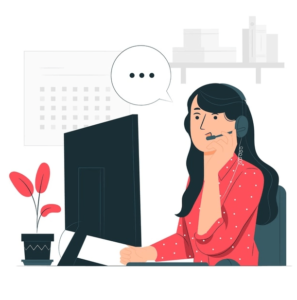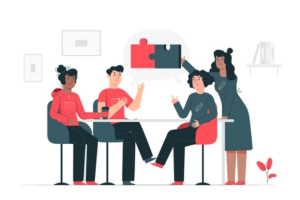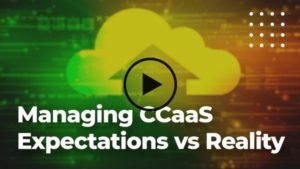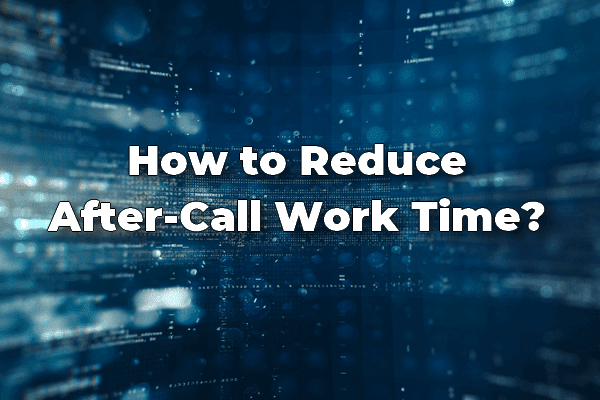A phone call should only be made once in a perfect contact center world. Both agents and customers would take note of all the crucial information communicated during a discussion – deadlines, expenses, follow-up activities, and so on – and reply appropriately to all of the other party’s expectations. – In an ideal world, both agents and customers would take note of all the critical information communicated over the phone – timeframes, fees, follow-up activities, and so on – and respond appropriately to all of the other party’s expectations.
Too often, however, agents fail to convey critical aspects of these talks to their colleagues, and customers don’t bother taking notes instead of relying on their faulty recollections! The failure of either party to follow up on a communication results in lost time and frustration for both parties! This is where after-call work (ACW) enters the picture.
While agents cannot always guarantee that the client on the phone will remember the facts of the conversation once they hang up, let alone follow up promptly, they may take responsibility for noting all aspects of the call and doing any necessary follow-up measures. In this article, we detail the best contact center strategies to reduce After-Call Work Time (ACW).
The Key role of ACW for Contact Centers
ACW is an abbreviation for “after-call work.” It is a metric that assesses how long it takes call center agents to document and finish activities following each client encounter. It mainly contains, the following:
- The reason for the interaction is recorded.
- The steps taken and the outcome.
- Following-up steps are being planned.
- The customer file is being updated.
- The reason for the phone call (eg. product return, service renewal, complaint)
- Tasks for the future
- Outcomes (customer satisfied with/will call back next week/hung up unhappy)
- Customer Attitude
- People who will be involved in the follow-up
- New information about the customer (started looking at other competitors, changing roles soon)
- Client’s special demands
 After-call work (ACW) is one of the most crucial key performances indicators for contact centers. It refers to the actions that must be completed by a customer service person after contact has concluded, as well as the time it takes for a representative to perform their post-call activities.
After-call work (ACW) is one of the most crucial key performances indicators for contact centers. It refers to the actions that must be completed by a customer service person after contact has concluded, as well as the time it takes for a representative to perform their post-call activities.
This KPI is an excellent method to quickly outline future tasks, such as updating coworkers or arranging appointments. ACW should occur soon following a call to ensure that no crucial facts are missed and that any shorthand notes made during the conversation can be fully expounded on. To reduce distractions to a minimum, incoming calls should be halted during this time period.
When completing Call Center ACW, there are four key steps for supervisors:
- Keeping track of any phone notes and providing a full synopsis
- carrying out any necessary measures
- appointing a representative to do a follow-up
- Call notes can be used to update CRM or help-desk tickets.
- Customer feedback analysis
Why is the ACW a must for Contact Centers?
No miracle solution will tell you how much time to set aside for after-call work. it depends on everything from your industry to your workload, internal structure, and the intricacy of a call. Though it should include all critical information given during the contact, it should be as brief as possible to prevent agents from logging redundant information that will need additional effort to go through later.
Incorporating after-hours work into your sales or customer support processes may help your contact center in different ways:
- Keep detailed recordings of talks.
- Assist with new recruit orientation
- Spend less time on customer calls.
- To avoid asking clients for the same information again and over,
- Enhance agent time management.
How can you lower your ACW?
The correct tools for your call center will save your agents time. The more clear and precise the interface is, the more efficient your agents will be. They can even conduct part of this work while on the phone with customers, describing what they are doing and how it will help them (making sure they have the right information, the right date, the right interaction topic, etc.).
Furthermore, the evolution of CCaaS technologies currently provides solutions that ease qualifying and resolution work by recommending categories and solutions. As a result, the agent is assisted in the entry and closing of the case, resulting in increased efficiency and productivity.
Ongoing training
 Agents should be trained frequently and consistently from the moment they are employed. Make it clear to agents that time spent working after a call is more than simply a few minutes to de-stress before moving on to the next call, but that it makes a significant difference in the quality of their job – for themselves and everyone else. Using call monitoring and supervision solutions that offer you immediate access to agent calls is an excellent method to simplify training.
Agents should be trained frequently and consistently from the moment they are employed. Make it clear to agents that time spent working after a call is more than simply a few minutes to de-stress before moving on to the next call, but that it makes a significant difference in the quality of their job – for themselves and everyone else. Using call monitoring and supervision solutions that offer you immediate access to agent calls is an excellent method to simplify training.
Optimizing training for call center employees is an excellent approach for reducing post-call work time. Don’t be hesitant to spend the time and effort necessary to train your agents before adequately putting them on the phone. This is not the sort of work where you learn on the job; agents frequently spend too much time studying your interface and seeking the correct button or tab to submit their ACW information. Eliminate these time-wasters by ensuring that all agents are aware and comfortable with your software and business tools before allowing them to work on their own.
It’s also a good idea to tell agents the measures managers use to assess overall call center effectiveness. When they understand that supervisors may utilize post-call work metrics as a point in their routine performance assessments, it encourages them to work as effectively as possible and motivates them to finish their ACW as fast as feasible. In addition, proper contact center agent training and preparation can significantly minimize the amount of time spent on ACW every week by minutes or even hours.
Training simulations for contact center agents come in a variety of forms. From our Podcast Series StoriNancy Munro CEO & FounderVerbal Transactions and a contact center training simulations specialist, explain what these are and how they vary from one another. Discover The Different Types of Training Simulations in our Serie First Contact Podcast
Customizing your CCaaS software tools
The flexibility to customize cloud-based call center software to your company’s specific ACW requirements is a significant advantage. Use the software’s functionality, for example, to build a shared call inbox where agents may log in and view which calls require attention. In addition, managers may see a comprehensive history of all calls handled during a certain time period. This helps them observe which agents are suffering from ACW and which may be deployed as trainers throughout the new employee onboarding process.
Another excellent example of lowering agent ACW is automated processing, which allows the client to read the terms and conditions, fill out a form, sign papers, and settle payments while the agent directs and makes notes to complete the transaction or any other sort of ACW.
The ability to accomplish all of this during the call decreases ACW. It also improves the customer experience, which boosts customer loyalty and NPS. Furthermore, because practically all ACW can be addressed during the conversation, agents may move on to the next caller faster, increasing contact center SLA and enhancing contact center efficiency.
You can also create intelligent routing rules to deliver callers to the highest competent and available person. This implies that the caller’s request may be processed more quickly and easily, making it easier for the agent to summarize his feedback notes and reduce repeats.
 CCaaS can help Contact Centers stay competitive in the ever-changing business industry, but Frank WassenberghCCaaS Practice Leader & Managing Partner at Cloudlinx believes it requires some expectation management. From speech analytics to QA/QM and gamification, it all comes down to compatibility and the correct fit for the firm. Discover more about Managing CCaaS Expectations vs Reality topic on our podcast First Contact Stories of the Call Center
CCaaS can help Contact Centers stay competitive in the ever-changing business industry, but Frank WassenberghCCaaS Practice Leader & Managing Partner at Cloudlinx believes it requires some expectation management. From speech analytics to QA/QM and gamification, it all comes down to compatibility and the correct fit for the firm. Discover more about Managing CCaaS Expectations vs Reality topic on our podcast First Contact Stories of the Call Center
CCaaS Integration
Integrating your CCaaS Solution with other critical business systems, such as CRM, is one of the most effective methods to enhance ACW. Switching between systems and updating each system with call center software call notes can be time-consuming and labor-intensive. However, if you integrate the systems, the information will be automatically loaded into each.
This not only offers a clearer picture of all call center activities but also significantly improves ACW efficiency. It also reduces the number of mistakes that might arise when manually uploading information. Because it is automated, you can rest assured that the correct information is being transferred to all programs, including your support software, CRM, and others.
Many contact centers have used servers to keep their software systems running for decades with no problems. Today, though, we’re talking about flexible technology in a rapidly evolving digital environment. And this new environment requires powerful technologies, hence why contact centers must shift from on-premise to cloud-based solutions.
Setting up a Feedback loop
As a company expands, its demands vary, as do the needs of its customers and agents. Collecting feedback from agents is crucial for understanding their issues and improving the ABS process. Your agents are at the core of your customer service operations, and they are the most knowledgeable on how to improve the ABS process to make it more successful and efficient.
You may set up a feedback loop to guarantee that you get useful input from your agents. This will entail gathering and evaluating data, as well as devising and executing effective solutions. When developing these solutions, keep your agents’ issues and obstacles in mind, since they will make the overall ABS process more efficient.
Auditing post-calls
Post-call time is both valuable and costly. Managers should develop the practice of analyzing the process in place on a regular basis in order to identify and resolve gaps and inadequacies. Every second an agent spends away from the phone costs the organization money. It is consequently in everyone’s best interest to ensure that agents are making the greatest use of their time on and off the phone. The audit will also identify any flaws in standard operating procedures (SOPs).
 Real-time monitoring refers to the ability to detect when an event occurs and aid an agent in managing the call appropriately and delivering the necessary information. However, the debate is still on, about whether this eliminates the need for post-call analytics. Find out more about call deflection, real-time monitoring vs post-call analytics, the Future of Post-Call Analysis in Contact Centers, and much more with Marc Bernstein CEO & founder of Balto.
Real-time monitoring refers to the ability to detect when an event occurs and aid an agent in managing the call appropriately and delivering the necessary information. However, the debate is still on, about whether this eliminates the need for post-call analytics. Find out more about call deflection, real-time monitoring vs post-call analytics, the Future of Post-Call Analysis in Contact Centers, and much more with Marc Bernstein CEO & founder of Balto.
Conclusion
 Setting up the correct KPIs for your contact center is critical. They let you take a picture at a certain point in time and illustrate the evolution over time. All of these metrics, in general, are dependent on two variables: people (the quality of your recruiting, training, onboarding, and management) and technology (the relevance of your internal tools, your technical platforms, and their ability to adapt to your daily life). You now know what you must do about this crucial KPI!
Setting up the correct KPIs for your contact center is critical. They let you take a picture at a certain point in time and illustrate the evolution over time. All of these metrics, in general, are dependent on two variables: people (the quality of your recruiting, training, onboarding, and management) and technology (the relevance of your internal tools, your technical platforms, and their ability to adapt to your daily life). You now know what you must do about this crucial KPI!
With more than 20 years of experience being a carrier and a call center software provider, NobelBiz is the Promise Keeper of the industry. And we are committed to offering the lowest cents per min rates, highest KPIs contact rates, safety, and a seamless customer experience for your contact center.
With years of experience in the trenches of CCaaS Solutions, we’ve designed a framework, process, and methodology for deploying Contact Center technology that delivers maximum ROI while reducing risk. Working with NobelBiz comprehensive suite of solutions will give you:
- Voice carrier network designed especially for contact centers with the best rates/prices
- World-Class Contact Center Software with fast implementation and excellent customer support for your contact center
- High-Quality Carrier-of-Carriers Network with low rates for call centers who want to give their customers the best there is.
- A true Omnichannel CCaaS Solution blending all communication channels with fast implementation and 24/7 support.

Abdelmounim Benharouga has always had a strong passion for writing and digital marketing. He started as a Digital Content Writer part of marketing department then moved to being Customer Success Manager for the African Region within the Nobelbiz team.








